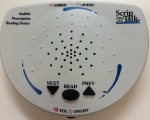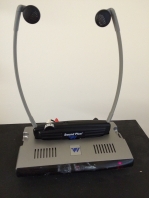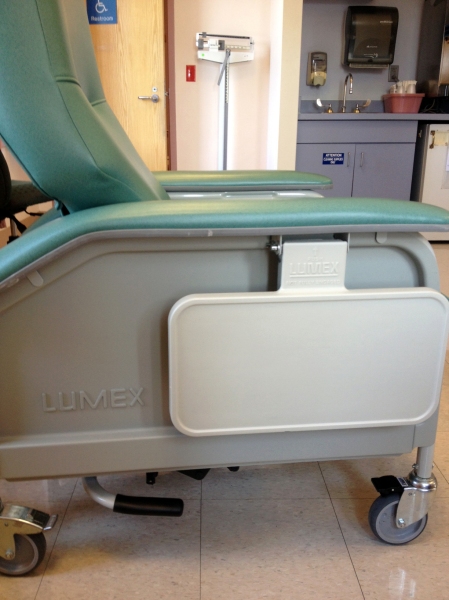I was visiting someone recently who has severe vision and hearing problems. The number and types of assistive devices that he has is amazing. Most of them came from the US Department of Veterans Affairs.
Memory takes the place of vision with some of these devices: each has its own controls and layout to remember. It’s quite amazing to watch someone use them all. Click the images to see them larger.
 The ScripTalk Station reads prescription labels aloud. It gets information from an RFID chip in the label, so the medication has to come from a pharmacy that uses these labels (like the VA).
The ScripTalk Station reads prescription labels aloud. It gets information from an RFID chip in the label, so the medication has to come from a pharmacy that uses these labels (like the VA).
An occupational therapist provided some interesting tips: put a rubber band at the top of a bottle for morning doses, and at the bottom for evening. Turn the bottle over after taking the meds, then reset it the next day.
 As it says on the handset, this is a LOUD telephone. I had to turn it way down to use it. The buttons are large enough for many low-vision people (and I blurred out the names on the top of the phone).
As it says on the handset, this is a LOUD telephone. I had to turn it way down to use it. The buttons are large enough for many low-vision people (and I blurred out the names on the top of the phone).
People with severe vision problems can contact the phone company to get an exemption from directory assistance charges. AT&T offers services through its Accessibility & Disability Services and The National Center for Customers with Disabilities.
 Williams Sound makes SoundPlus TV listening devices like this. The base connects to the television, and sends the sound via infrared signals to the receiver, which the listener wears.
Williams Sound makes SoundPlus TV listening devices like this. The base connects to the television, and sends the sound via infrared signals to the receiver, which the listener wears.
Sound on the television can be at a regular level for people without hearing problems, and the wearer can adjust the volume on the receiver.
 Two reading devices: On the left, is a magnifier. You can see the corner of a yellow page under the screen. This is good for simple documents.
Two reading devices: On the left, is a magnifier. You can see the corner of a yellow page under the screen. This is good for simple documents.
On the right is the Extreme Reader by Second Vision. It does text-to-speech conversion and reads documents out loud. You can see a newspaper in the device, and the simple control panel with four big buttons. It’s obviously slower than reading on your own, but it’s an amazing thing to have when you can’t.
 This HealthSmart blood pressure cuff speaks instructions, measures blood pressure and then speaks the results. It provides a general diagnosis (“According to World Health Organization recommendations…”)
This HealthSmart blood pressure cuff speaks instructions, measures blood pressure and then speaks the results. It provides a general diagnosis (“According to World Health Organization recommendations…”)
I saw a similar device for measuring blood glucose levels.
 Not everything is electronic. Large-print calendars like this are very helpful. One source for them is LS&S, “the catalog of products for the visually impaired and hard of hearing”. Other simple accommodations include small velcro strips on washing machines and dishwashers to help get oriented on the control panels.
Not everything is electronic. Large-print calendars like this are very helpful. One source for them is LS&S, “the catalog of products for the visually impaired and hard of hearing”. Other simple accommodations include small velcro strips on washing machines and dishwashers to help get oriented on the control panels.
 This one is my favorite: Press the red button to hear what color an item is, which can help vision-impaired people pick coordinating clothing (or carpets, for that matter).
This one is my favorite: Press the red button to hear what color an item is, which can help vision-impaired people pick coordinating clothing (or carpets, for that matter).
Press the yellow button to get an audible signal that indicates the light level of the room. You don’t want to invite friends over for coffee if they can’t see the cake!



 Posted by Hal Shubin
Posted by Hal Shubin 

